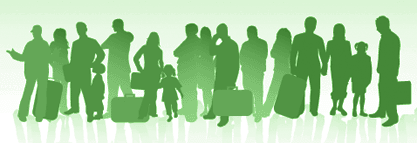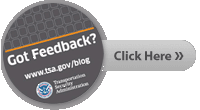
Okay, we continue to receive questions on the ID requirement. I will attempt to answer as many as possible below. It’s kind of a virtual chat. We’d love to be able to do a live chat and we’re exploring that technological possibility.
There is also the very real possibility that civil people can agree to disagree…which is the direction I believe we’re heading.
Here goes:
Anonymous said... Could you please elaborate on those approximately 20 persons that weren´t allowed to fly? June 23, 2008 4:51 PMSure. The 20 people of the 10 million plus that did fly were turned away from the checkpoint. Some went and got their IDs, some tried to fly from other airports (and were stopped) and the rest just didn’t come back.
Phil said... TSA: If the people on your blacklist are so dangerous that we must restrict their movement, why don't you send the police to arrest them and put them in front of a judge? June 23, 2008 4:52 PMCouple things here Phil. First off, TSA doesn’t have a “blacklist.” We use two of the Terrorist Screening Center’s watch lists, no-fly and selectee. The no-fly is reserved for known threats to aviation, most of which are not in this country and are not exactly sitting around, waiting for a visit from any government official, U.S. or otherwise. While the exact number of “no-flys” is secret, there are many, many less than 500,000. No Ted Kennedy and other are NOT on the no-fly list. If a person truly is, they “NO FLY” get it?
The other list is the selectee list. This list is for people that require additional screening before they fly. They fly after undergoing additional screening..
Anonymous said... So you're saying that you've been letting 10 people too dangerous to fly on planes each and every day since your misbegotten agency started? June 23, 2008 5:03 PM
Huh??? What we’re saying is that identity matters and we’re strengthening the system by verifying ID.
Chris Boyce said... 1. Where is the privacy impact assessment for the new form and the obviously commercial datamining check? I don't recall seeing it on line, nor do I remember a public comment period. We wouldn't be breaking the law, would we???
No Chris, we wouldn’t be breaking the law. A privacy impact assessment has been conducted and is pending review at DHS prior to being posted. There is no public comment period for Privacy Impact Assessments. Also, commercial “datamining” is not an accurate description of what is happening. We are simply using commercial data as a way to assist individuals in verifying their identity when they otherwise are unable to establish it through an acceptable identity document. Commercial data is not being used to predict criminal or terrorist activity.
2. Why would Hawley state on CNN that he was confident that his new policy would withstand a legal challenge if it weren't retaliatory in nature? Surely even he would know that it's unlikely that lawsuits are a known Al Qaeda tactic. June 23, 2008 5:13 PMHuh? The question from the reporter was, “Would this new procedure withstand a lawsuit?” The answer was yes. Had the question been, “Will Al Qaeda sue you over this new procedure,” the answer would have been different.
Marshall's SO said... OK, so now we know what kinds of questions travelers, even those who are lying, are asked when they say they "forgot" their ID, i.e., birthdate, previous address, political party affiliation, where are you getting the data from to ask such questions? Can you verify that whatever data service you are using has "good" information? June 23, 2008 5:24 PM
Thanks Marshall. Just for the record, we’re not asking “political party affiliation” as you suggest nor are we asking other sensitive question like religion, charitable donations or things like that (see Kip’s comment on the ID post from the other day). Based on the publicly available data we’re using, we have a range of questions and it’s not a one strike and you’re out procedure. There are a number of questions we ask simply to determine if you are who you say you are. That’s it.
Because of the number of questions that could be asked, we’re also preventing someone from memorizing a simple set of facts to game the system.
Anonymous said... The average length of time for these ridiculous checks tells us nothing. What was the longest length of time you detained a citizen seeking to travel by air who did not have an ID? What was the shortest? June 23, 2008 5:40 PM
I feel like the average length of time is an important data point on how this is going. That said, the longest length of time we took to make an identity verification decision was 47 minutes. Yes that’s a long time and may have caused that one individual to miss his or her flight. The quickest is in the seconds.
Don’t know if the person waiting 47 minutes was a citizen or not but detained is not an accurate term either.
Boy, this anonymous character sure asks a lot of questions. :)
Travel_Medic said... how is checking IDs add anything to security when they are not compared to any list. June 23, 2008 7:31 PMHello Doc. You are compared to no-fly and selectee lists by the airlines. Verifying identity is an additional layer of security because it is added to the other layers…namely travel document checkers and the airlines checks against the above mentioned two watch lists. By doing all three, we’re verifying people are who they say they are, they are not on the no-fly list and their documents are legit.
Just yesterday (July 1), we identified a passenger with a fake social security card. Last week, we found a fraudulent passport. Altered documents are a staple of criminal and terrorist activity. We’re playing offense here and not giving free shots to a patient enemy.
Bob Eucher said... What became of the 20 people that were considered "too dangerous to fly"? Arrested? Let go? June 23, 2008 8:09 PMBob, I loved you in
Major League (yes the last name is spelled differently but it was too close to resist). We’re not saying these people are “too dangerous to fly.” We’re saying we can’t verify they are who they say they are.
You and others might not care who sits next to you on that plane but we do.
Trollkiller said... ONCE AGAIN, I CHALLENGE THE TSA TO PROVE THE TWO SECTIONS OF 1540 THAT THEY CITE (§ 1540.107 & § 1540.105 (a)(2) ) GIVE THEM ANY AUTHORITY OR RIGHT TO DEMAND AN ID AS A CONDITION OF ACCESS TO A STERILE AREA June 23, 2008 10:06 PMTROLLKILLER…MY VOICE IS GETTING TIRED FROM SCREAMING. Our attorneys interpret ATSA as saying we can do this, we think it’s important so we’re doing this. I’m not an Internet-based attorney but I probably could play one on TV.
Anonymous said... Again, if the airlines need to verify whether the person boarding the plane is the correct person, they could ask for ID at the gate. But why get the government involved in this? June 23, 2008 10:30 PM
The government is involved in this because we’re charged with aviation security. The airlines were charged with aviation security until TSA was formed in late 2001. We partner with said airlines to ensure no-flys aren’t getting on planes and that we do know who is. We supplement that with trained document checkers, identity verification, behavior detection officers and more than 15 other layers of security.
Anonymous said... So it only took 48 hours before the first reported instance of a question about political affiliation being required. I'll make two predictions: 1) The TSA employees who did this will never be reprimanded in any serious manner; the worst thing they will face will be some additional "training". June 23, 2008 10:35 PM
Nostranonymous, I think Kip was pretty clear when he wrote, “"It's unequivocally not our policy to use political, religious, or other sensitive personal topics as identity validation. If it happened, it was wrong and will not be repeated."
The person that did this made a mistake and has been corrected. Hope you never make a mistake at your job.
Anonymous said... Just out of curiosity, do you guys run my credit report if I show up with no ID? That's the only way I can think of you'd be able to validate I am who I say I am. June 23, 2008 10:46 PMNo. We’re not concerned about that Columbia House bill you never paid in college. We use publicly available info to verify you are who you say you are. It’s taking about 6 minutes for the .00005 percent of people that show up without ID every day.
Andy said... TSA, Question 1: You repeatedly claim this helps improve no-fly list enforcement. As we have told you over and over again, the ID checkers aren't checking names against a list. They're just comparing the name against the boarding pass, and the face to the ID. So, how exactly does this new policy enhance the NFL enforcement?
Andy, you can tell me “over and over again” that document checkers don’t check against the no-fly list and it’s still not the point. Airlines check against the no-fly, trained document checkers check validity of IDs, we verify identity of those without ID. The three work in combination.
You can say 1 plus 1 equals 7 a thousand times and it still doesn’t make it so.
Also, at the risk of hijacking this thread, we are also working on assuming responsibility for watch list matching from the airlines through our Secure Flight program. We believe this will also strengthen the watch list matching and greatly reduce the misidentifications that occur today.
Question 2: What exactly was wrong with the old policy (claim you have no ID, you get a SSSS and you're on your way)? We technically can still do that, and remember when there's a will, there's a way. There's no such thing as perfect security.
You’re 100 percent right on this on point Andy. There is no such thing as perfect security. The combo of the three layers above is better that the old system when anyone shows up, says “no ID” they get screened and go on their merry way. Keeping no-flys off planes is good security and simply patting down someone does not verify identity.
Question 3: Why are you targeting those who simply refuse to show ID? Some people refuse to show ID because of: identify theft concerns; religious reasons; self-privacy reasons; and/or their own principle. We are free people here in the USA, and we have a right not to show ID. People can lie and say they lost their ID, and get by, but those truly wanting to stand up for their rights will be punished. Is there a political connection to this? I think it's blatantly obvious what your purpose is here, TSA. June 24, 2008 5:08 PMNo political connection Andy, none at all. It’s all about strengthening security. There’s no “targeting.” People are showing up without ID and we’re verifying identity, simple as that. We believe we have the legal authority and we believe this increases security.
Anonymous said... Seriously, what happens if you are a physically disabled person and you've never had an official, government-issued photo ID made because you don't drive or use other services that require such ID? I know of several people with seizure disorders and severe dyslexia who have never gotten a state ID because they simply didn't need one. Their sole photo IDs were their college IDs - nothing official or certified. June 25, 2008 7:41 PMNo problem anon, we work with these individuals to establish their identity just like we would anyone else.
yangj08 said... How are you going to deal with foreign passports? I've already heard of someone having to go through a secondary because the TSO at an airport didn't recognize his Dutch passport. He had to go through a secondary (even though he had valid ID). So what happens to those people (especially if it's someone that doesn't speak English very well)? June 26, 2008 2:14 PMApples and oranges Yang. If a passenger has legit ID, including a Dutch passport, off they go. Being subjected to additional screening is not the same as verifying ID.
Anonymous said... Can you please elaborate on how the false positive problem will be addressed? I am currently on the Selectee list (and fed up with it) and want to know how soon this madness will end. June 27, 2008 9:04 AMWell, anonymous does appear to be a very common name so it might just be a misidentification…Honestly, false positives on the selectee list is a different matter. One we’re planning on addressing on the blog in the next few weeks.
I do encourage you to apply for redress at:
http://www.dhs.gov.trip/. You’ll also be glad to know (hopefully) that we’re in the process of taking over watch list matching and that will greatly (like 99 percent or greater) reduce misidentifications, which you are much more likely to be rather than a real-deal selectee.
Anonymous said... If they have no weapons, why does it matter WHO they are?
June 27, 2008 2:42 PM
Ah, this is the key argument. We honestly believe that identity is as important as going through the metal detector. Our partners in the law enforcement and intelligence communities work tirelessly and in some cases under great physical danger to identify individuals that pose a threat to aviation. The simple truth is that it would be negligent to not use this information to our advantage.
*** Anonymous said... How can requiring ID fit within our constitutional rights?
We’ve answered this repeatedly. Our position is that Gilmore v. Gonzalez affirmed our ability to require ID for transportation via air and the law that formed TSA, the Aviation and Transportation Security Act (ATSA) empowers the TSA to make these decisions.
How are the watch lists being improved? How did they come together in the first place? June 27, 2008 6:17 PMWhile the Terrorist Screening Center (TSC) maintains the lists and TSA is a customer of the no-fly and selectee lists we have worked closely with them to make the lists we use as useful as possible.
As was widely reported several months ago, TSC with TSA’s assistance completed a name by name scrub of the lists (no fly and selectee) and reduced them significantly. This reduces the number of misidentifications, making the list more effective.
As I have also said earlier, we’re also working to assume watch list matching from the airlines and this will have a great impact on the effectiveness of the watch lists.
means to authenticate the passenger's boarding pass.) June 27, 2008 6:50 PM
Abelard said...
1. If requiring ID is truly instrumental in keeping the flying public safe, why did it take the TSA until June of 2008 to institute that policy?Good question Abelard. We’ve been increasing layers of security for years and now that TSA officers check documents at every airport in the country, we’ve effectively moved the issue and are trying to address this threat.
2. What will the TSA due if a majority of the states refuse to issue READ ID cards to their respective citizens?
What’s READ ID? :) We’re already reading IDs…
We will be prepared to address that issue if it happens. Thusfar, every state in the union is working with DHS on REAL ID.
3. In general, what disciplinary action will be taken against a TSO who asks someone questions regarding their religion or political beliefs in order to verify their identity?The officer is not coming up with the questions, our 24/7 security operations center is using publicly available databases to determine the most appropriate questions. We’ve already said we don’t see the types of questions you bring up as appropriate.
1) Since anyone can photoshop a boarding pass to match their ID, couldn't someone just buy a ticket under any old name, change their boarding pass, and then proceed through security, with their own, legit ID, since none of your employees are checking the boarding passes to see if a) they're legit, or b) if the person whose name is on it is on your "no fly" list?Why do that when someone could just print a fake boarding pass at home? That’s why we have these layers I keep talking about. No-fly passenger forges boarding pass at home, shows up and has to beat document checkers, behavior detection officers, and the other layers. No self respecting terrorist is going to say “no ID” when he/she knows they’ll get the extra attention this process now entails.
See, we’re doing is forcing people with bad intentions into additional layers of security here.
2)What happens when someone truly forgets their ID, and the company you contract out with to verify has the wrong information?We don’t contract out with anybody. TSA employees at our ops center verify the identity with publicly available databases.
3) How does this stop someone who is not a known terrorist?Totally clean skins are still subjected to the other layers of security, particularly behavior detection officers.
4) Why, in their right mind, would a known terrorist use a legitimate ID to buy their ticket? Wouldn't they just get a good fake?
My sentiments exactly. See above.
5) What if someone is a forgetful person...how many times can they have forgotten their ID?? June 27, 2008 10:09 PM
As many as they want….
Hope these answers helped clear up our position and why we think this is so important. As I wrote in the beginning, it’s perfectly acceptable for rational, intelligent people to disagree on important issues.
Christopher
EoS Blog Team
Labels: mission, myth busters



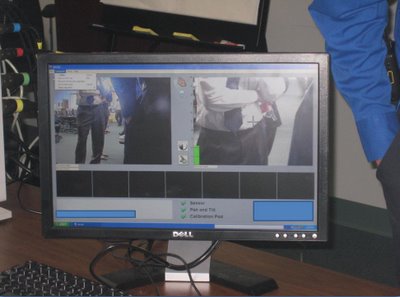


 If you are concerned or uncomfortable about going through the walk-through metal detector or Mill with your insulin pump, notify the TSO that you are wearing an insulin pump and would like a full-body pat-down and a visual inspection of your pump instead. Advise the Security Officer that the insulin pump cannot be removed because it is inserted with a catheter (needle) under the skin.
If you are concerned or uncomfortable about going through the walk-through metal detector or Mill with your insulin pump, notify the TSO that you are wearing an insulin pump and would like a full-body pat-down and a visual inspection of your pump instead. Advise the Security Officer that the insulin pump cannot be removed because it is inserted with a catheter (needle) under the skin.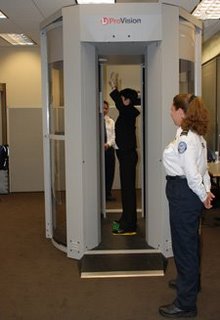
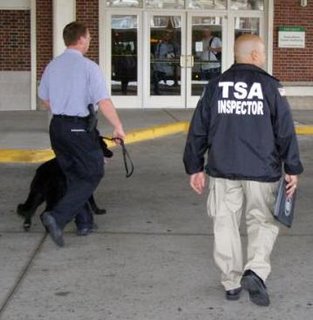


 Lynn’s husband asked a question similar to this after a recent trip, and we also get this question from people on the blog:
Lynn’s husband asked a question similar to this after a recent trip, and we also get this question from people on the blog: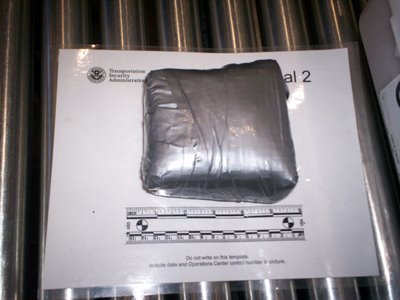
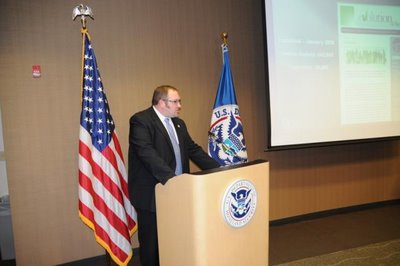



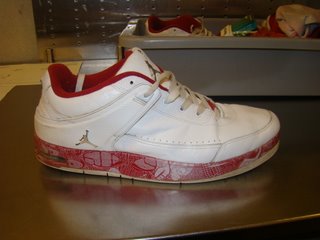





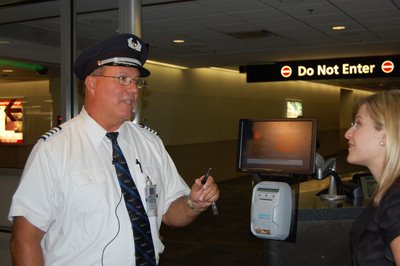

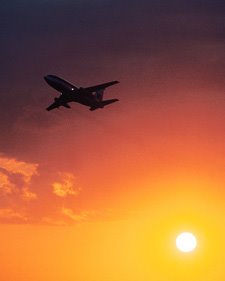
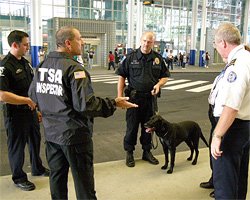






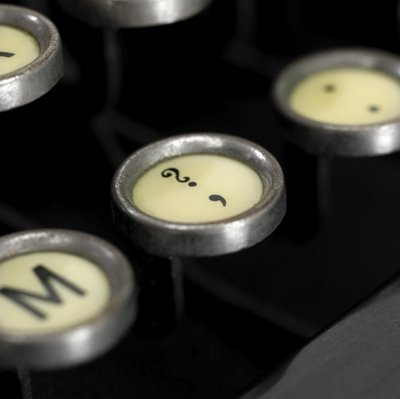





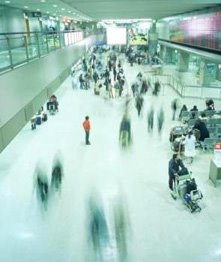


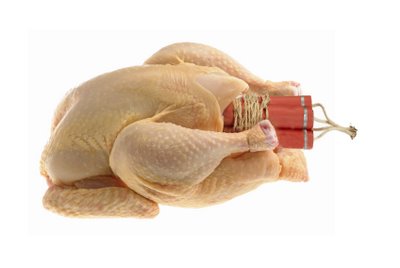


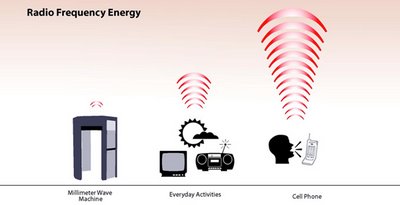
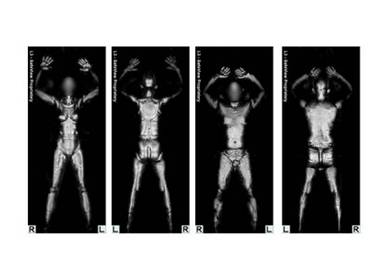 A millimeter wave machine looks like this:
A millimeter wave machine looks like this:
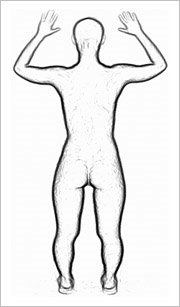
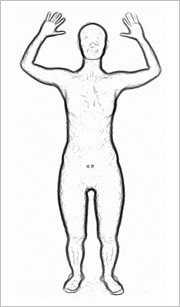
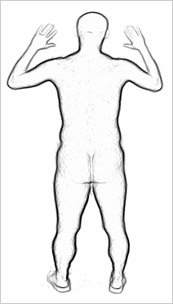
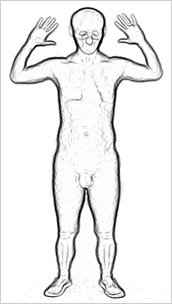



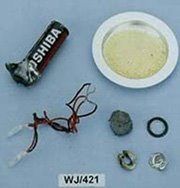







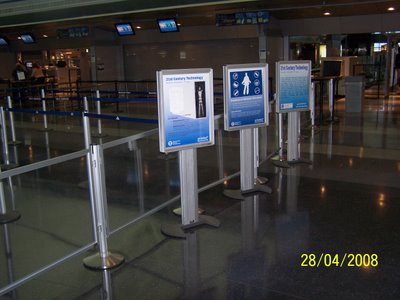


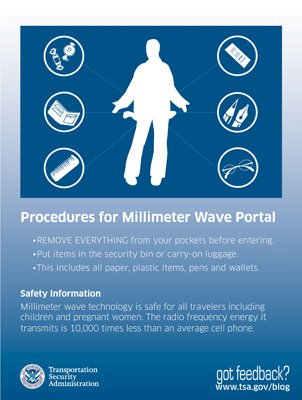
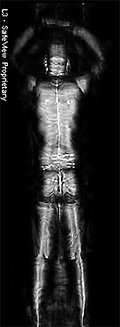



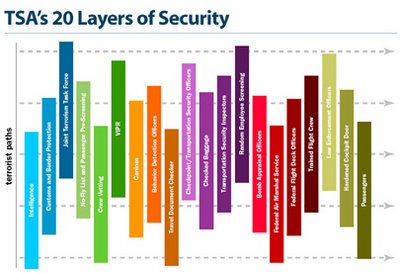
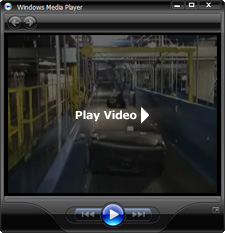

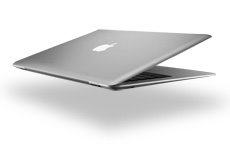
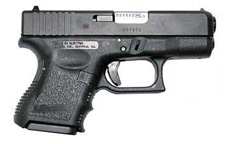 On any given day, there are dozens of reports sent in from airports ranging from routine to bizarre to truly scary. On Friday,
On any given day, there are dozens of reports sent in from airports ranging from routine to bizarre to truly scary. On Friday, 